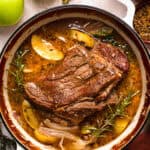
Apple Cider Braised Pork Shoulder
Looking for the ultimate braised pork shoulder recipe? This apple cider braised pork shoulder is fall-apart tender, packed with savory-sweet flavor, and cooked low and slow in the oven for that authentic, rustic, restaurant-quality taste — perfect for cozy weeknight dinners or holiday entertaining.
Servings 8
Calories 308kcal
Ingredients
- 3.5 pounds pork shoulder excess fat trimmed, pat dry
- salt and pepper to taste
- 2 tablespoon neutral cooking oil like light olive oil, canola, or avocado oil
- 8 cloves garlic minced
- 3 sprigs thyme
- 1 sprig rosemary
- 2 tablespoons apple cider vinegar
- 2 ½ cups unfiltered apple cider (NOT apple cider vinegar!!)
- 2 ½ cups chicken stock
- 2 tablespoons whole grain mustard or Dijon
- 1 large red onion sliced thick
- 2 Granny Smith apples firm, cored and cut into quarters or eighths
For Serving (Optional)
- Mashed potatoes or any starchy side
- thyme leaves
Instructions
- Position a rack in your oven to the middle and preheat the oven to 325 degrees.
- Heat the neutral oil in a large Dutch oven to medium high heat while you liberally sprinkle the dried pork shoulder pieces with salt pepper.
- Add the pork shoulder, and brown on all sides, about 5 minutes per side. Once browned, remove and set aside on a plate or tray.
- Add the garlic, thyme, and rosemary, cooking for about 1 minute until fragrant.
- Add the apple cider vinegar, apple cider, chicken broth, and whole grain mustard to the pot, scraping up any browned bits from the bottom.
- Gently place the pork back into the pot, cover, and cook in the oven for 2~2 ½ hours or until fork tender, flipping the pork pieces about halfway through the cooking process.
- Add the red onion slice and apple slices, cover, and return to the oven for another 20-30 minutes or until the apples are tender and softened. Adjust the braising liquid with salt and pepper if needed. Remove the herbs from the pot before serving.
- (Optional) You can remove the pork, apples, and onions from the Dutch oven and cook down the liquid on the stovetop for about 15 minutes on high, constantly stirring, if you want a thicker sauce.
- Either serve the pork in large chunks, or shred and serve. Accompany the pork with the sauce, apples, onions, and plate with mashed potatoes or your favorite starchy side! Garnish with thyme leaves if you wish and enjoy!
Notes
- Don’t overcrowd the pot when browning the pork or the pork will not brown properly.
- Pull the pork out when it’s fork tender. If the pork needs more time prior to adding the apples and onions, make sure to add on increments of 20-30 minutes to help the proteins soften and break down.
- If there’s a lot of residual fat on the top, you can always skim that off if you like.
- Reduce the sauce – Boiling down the braising liquid after cooking makes a glossy sauce that feels like something from a traditional French bistro.
- Cut apples into larger chunks so they don’t completely fall apart during cooking — they should still have shape when served.
- The nutritional info does not include optional sides like mashed potatoes.
Frequently Asked Questions
- How do I keep braised pork shoulder from drying out? The key is low-and-slow cooking in enough liquid. Pork shoulder is naturally fatty and connective tissue-rich, so cooking it at 325°F in a covered pot with enough liquid ensures the fat renders and the meat stays moist. Always keep at least ⅓ of the pork submerged in liquid during braising. If your pot is too big and the liquid level is low, add more broth or cider.
- How do I know when the pork is done? Instead of relying only on time, check texture. Pork shoulder is done when it’s fork-tender — you should be able to twist a fork in it easily and pull the meat apart without resistance. Internal temperature should be around 195–205°F for shredding.
Storage Tips
- Refrigerate: Store the cooled pork shoulder in an airtight container and put in the fridge for up to 5 days. Reheat to desired temperature.
- To freeze, place the cooled pork shoulder in an airtight container. It can be stored in the freezer for up to 2 months.
You'll Need These Supplies
- cutting board
- knife
- measuring cups
- measuring spoons
- large Dutch oven
- tongs
Nutrition
Calories: 308kcal | Carbohydrates: 20g | Protein: 26g | Fat: 13g | Saturated Fat: 4g | Polyunsaturated Fat: 2g | Monounsaturated Fat: 7g | Trans Fat: 0.01g | Cholesterol: 83mg | Sodium: 245mg | Potassium: 658mg | Fiber: 2g | Sugar: 14g | Vitamin A: 56IU | Vitamin C: 6mg | Calcium: 41mg | Iron: 2mg